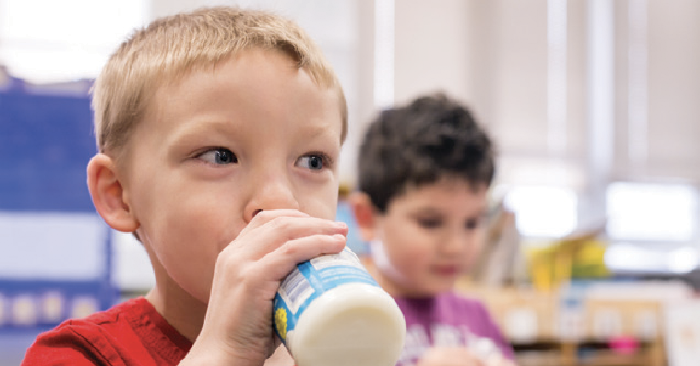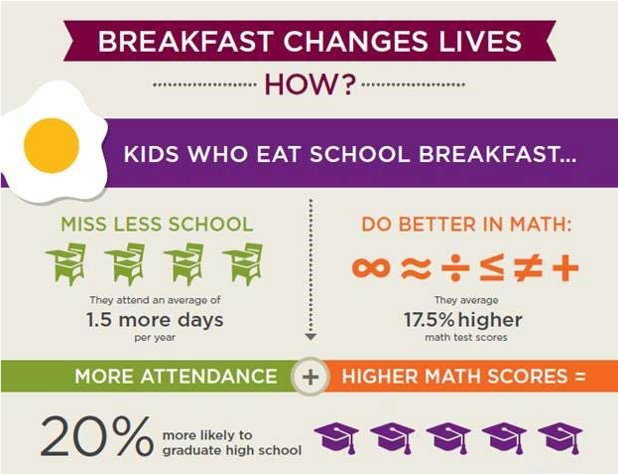
School Breakfast Planning Toolkit

Eating breakfast has been shown to improve classroom behavior and academic outcomes, and is important for helping kids grow up healthy. But because of barriers preventing students from eating breakfast, such as students unable to get to school in time to eat breakfast in the cafeteria, or students socializing with their friends in the morning, too many kids in Hawai‘i are going without breakfast. Hawai’i is ranked 50th in the nation for school breakfast participation, with less than 4 in 10 of our low-income students getting a free or reduced-price breakfast at school.
We can ensure more of our keiki start their day right by switching up the way we offer breakfast in schools. In the 2018-19 school year, First Lady Dawn Amano-Ige teamed up with the Department of Education, local and national non-profits, and local businesses to launch the Jump Start Breakfast initiative aimed at providing more students with the opportunity to eat school breakfast and start their day healthy and ready to learn. Through breakfast model pilot testing, the team learned that innovative models like grab-and-go or second chance breakfast, as well as morning breakfast clubs, can help ensure more kids take advantage of this program. Marcus Mariota even got involved!
We want you to get involved, too! This toolkit has been designed to help you plan and implement your Jump Start breakfast initiative and make sure that more students at your school start the day with a healthy meal to last them to lunch. Thank you for being a school breakfast champion!
Step 1: Assemble your Jump Start Breakfast leadership team
Engaging stakeholders provides an opportunity to educate them about the importance of expanding access to school breakfast, address concerns, and inform them about how the new model may alter their morning routine.
Set up a regular meeting schedule for the team to facilitate planning, troubleshoot, and manage expectations of the breakfast program.
Team members can also be powerful advocates for promoting the program to their peers. Recruiting members from your school’s wellness committee is a great place to start. Be sure to include the following critical players:

CAFETERIA MANAGER

PRINCIPAL

TEACHER

CUSTODIAN

STUDENT

NURSE
Here’s a link to a form for you to list the members of your Jump Start school breakfast leadership team.
Step 2: Assess your current school breakfast program and choose a Jump Start Breakfast model

Every school’s morning routine is unique. It’s important to spend time thinking about your school’s current breakfast program before choosing the Jump Start model that would be the best fit for your school. Here are some questions to help you assess your current school breakfast program:
Why don’t more students eat breakfast at your school?
- Do the school buses arrive early enough? Are a lot of kids tardy?
- Do they prefer to socialize and play instead of eating breakfast?
- Is the cafeteria far away from where they get dropped off and/or their classrooms?
Which of the following changes would work best at your school?
- Serving breakfast after the first bell?
- Setting up breakfast kiosks where kids hang out or walk to class?
- Encouraging all students to report to the cafeteria at the start of the day?
Choose one of the Jump Start Breakfast models below:

Grab and Go to the Classroom (GNG): Students pick up breakfasts from mobile service carts in high traffic areas that are convenient to students, such as hallways, entryways or cafeterias. Students can eat breakfast before and after the bell has rung.
- Learn more about how GNG works by watching this video by No Kid Hungry.
- Watch this video about the benefits of GNG to the classroom breakfast at an elementary school.
- Learn how Grab and Go can work well in a high school with this video.

Second Chance Breakfast (also called Wiki Breakfast): Students eat breakfast during a break in the morning, often between first and second period, or midway between breakfast and lunch. Wiki is served via GNG, or in the cafeteria.
- Tip – This is effective for middle or high school students who may not be hungry first thing in the morning and get to school just before the first bell rings.
- Learn more about how Wiki Breakfast works by watching this video by No Kid Hungry.
- Watch this Hawaii News Now video about Kamaile Academy’s successful Wiki Breakfast program.

Breakfast Club: All students report directly to the cafeteria when they arrive at school for fun activities and to enjoy breakfast together as a school. Incorporating this strategy can encourage kids to show up early and to make healthier choices when they are presented with options for food.
- Watch this video from HSTA that highlights Fern Elementary’s successful Breakfast Club.
- Hawaii schools are fashioning unique school design profiles reflecting the strengths and aspirations of their communities. Including the cafeteria and eating spaces in school design plans can better prepare students to learn.
- Check out these exciting cafeteria concepts to spark inspiration for your cafeteria transformation!

Breakfast in the Classroom (BIC): Students eat breakfast in their classroom after the official start of the school day. Students or cafeteria staff deliver breakfasts to classrooms from the cafeteria. BIC takes 10 to 15 minutes on average. Schools see the greatest breakfast participation increase with this model.
- Tip – this model works great in elementary schools
- Learn more about how BIC works by watching this video by the Alliance for a Healthier Generation.
- Watch this video about how BIC helps students get ready to learn.
- See this video about how BIC turns classrooms into communities.
Innovation Model: Schools will have the opportunity to develop a model of their choice. Schools will submit their model to School Food Service Branch (SFSB) for approval. Once approved, SFSB will provide technical assistance to ensure that the model complies with USDA policies.
Step 3: Develop a Jump Start Breakfast implementation timeline

The Jump Start Breakfast leadership team should create a timeline for the various stages of implementation.
Grab and Go to the Classroom:
- Take a look at this detailed GNG to the Classroom rollout timeline from No Kid Hungry.
- Get some ideas from this GNG breakfast quick guide from Massachusetts.
Wiki Breakfast:
- Find some ideas in this Second Chance breakfast quick guide from Massachusetts, which includes a sample timeline.
Breakfast Club:
- Visit the Smarter Lunchroom website for tips and ideas on increasing the number of reimbursable meals you serve.
Breakfast in the Classroom (BIC):
- Take a look at this detailed Breakfast in the Classroom rollout timeline from No Kid Hungry.
- Get some ideas from this BIC breakfast quick guide from Massachusetts.
Remember to include community outreach in your plan:
- This toolkit from the Food Research and Action Center and National Association of Secondary School Principals includes sample outreach materials and plans.
- More outreach resources that you can use are provided below in Step 5.
Consider adding a “dress rehearsal” before your official launch date:
- The rehearsal can help to identify any unexpected issues and give stakeholders additional time to troubleshoot. Schools may also opt to stagger the roll out, implementing in a few classes or grades during the first week before expanding school-wide.
Here’s a link to a form for you to list the milestones of your Jump Start school breakfast implementation timeline.
Step 4: Identify and purchase needed equipment & supplies.
The Jump Start Breakfast leadership team should create a list of any equipment and supplies that your school will need to successfully implement your new breakfast model. Here are some common items:
- serving kiosks, carts, or tables.
- point of sale units .
- food/beverage coolers and containers.
- bags or boxes for meals.
- classroom cleaning supplies.
- more trash cans and bags.
- more places for students to eat.
Check out this alternative breakfast equipment guide from The Lunchbox for detailed lists and photos of equipment and supplies.
Here’s a link to a form for you to list the equipment you’ll need for your new Jump Start Breakfast model.
Step 5: Remember to get the word out about your Jump Start Breakfast plans

This No Kid Hungry flyer talks about childhood hunger in Hawaii and why school breakfast is part of the solution.
This flyer from No Kid Hungry explains the ways that Breakfast after the Bell can help your school.
Breakfast for Learning from the Food Research and Action Center lists evidence that school breakfast helps improve academic outcomes.
Breakfast for Health from the Food Research and Action Center lists research that supports the dietary, obesity, and health benefits of school breakfast.
This No Kid Hungry Outreach Resource provides guidance and resources to connect with school, district, and community stakeholders.
This toolkit from the Food Research and Action Center and National Association of Secondary School Principals includes sample outreach materials and plans.
Step 6: Contact School Food Services Branch to get your plan started!
Phone: 808-784-5500
Email: NSLP@k12.hi.us

